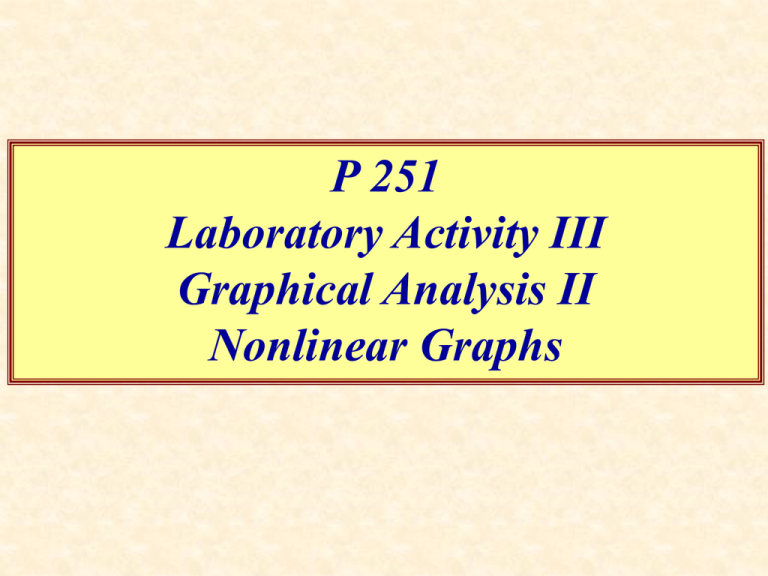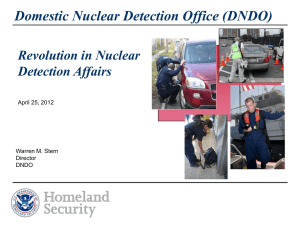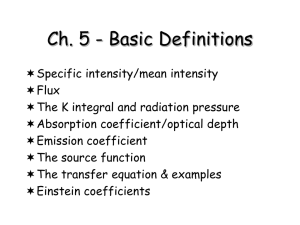graphical_analysis_2A
advertisement

P 251 Laboratory Activity III Graphical Analysis II Nonlinear Graphs Graphical Analysis Exercise Determining the Relationship between Circumference and Diameter Procedure: 1. Measure the Circumference and diameter of five circular objects. 2. Analyze data using graphical analysis. diameter, cm 2.1 4.8 8.8 11.5 17 DATA Circumference, cm 7.5 15.4 28.3 36.2 53.1 Plot a graph of Circumference versus diameter. CALCULATIONS AND OBSERVATIONS: 1. Is your graph a straight line? YES 2. Does the graph pass through the origin? YES…b = 0 3. Are circumference and diameter directly proportional? YES 4. Calculate the slope; Points Used: (4.8cm,15.4cm) & (11.5cm,36.2cm) slope m Y C 36.2cm 15.4cm X d 11.5cm 4.8cm 20.8cm 3.1 6.7cm Slope has NO units What is the equation relating Circumference and diameter? Y = mX+b C 3.1 d + 0 C 3.1d Compare slope = 3.1 to p (3.14) % error experimental value - accepted value accepted value 3.1 3.14 .04 100% % error 100% 3.14 3.14 100% 1.3% Non-Linear Graphs What procedure do we follow if our graph is not a straight line? Consider an experiment designed to investigate the motion of an object. We want to determine the relationship between the object’s distance traveled and time. We measure its distance each second for 10s. Here is the resulting data. Data time-t, s 0 1 2 3 4 5 6 7 8 9 10 distance-d, m 5 9.9 24.6 49.1 83.4 127.5 181.4 245.1 318.6 401.9 495 We then plot a graph of distance versus time. Distance versus Time 500 Not a straight line but is a uniform curve 450 400 distance, m 350 300 250 200 150 100 50 0 0 1 2 3 4 5 6 time, s 7 8 9 10 11 Compare graph to graphs of other functions of the independent variable 7 y =x Y X 6 Y mX b 5 4 Y 3 2 1 0 0 1 2 3 4 X 5 6 7 40 y =x2 YX Y mX b 2 30 Y 2 20 10 0 0 1 2 3 4 X 5 6 7 y = x1/2 2.5 2 1.5 Y X Y Y m X b 1 0.5 0 0 2 4 X 6 8 1.25 y = 1/x 1 Y X 1 Y m 1 b X 0.75 Y 0.5 0.25 0 0 1 2 3 4 X 5 6 7 1.25 y = 1/x2 1 Y 2 X Y m 12 b X 1 0.75 Y 0.5 0.25 0 0 1 2 3 4 X 5 6 7 1.1 y = 1/x1/2 1 1 Y X 0.9 1 Ym b X 0.8 Y 0.7 0.6 0.5 0.4 0 1 2 3 4 X 5 6 7 7 40 Y X y =x Y X2 6 Y mX b 5 y = x1/2 2.5 y =x2 2 Y mX b 30 2 Y X 1.5 4 Y 20 Y 3 2 10 Y Y m X b 1 0.5 1 0 0 1 2 3 4 5 6 0 0 7 0 X 1 2 3 4 5 6 0 7 Y 0.5 8 1.1 1.25 y = 1/x Y 12 X Y m 12 b X 6 X y = 1/x2 0.75 4 X 1.25 1 2 Y 1 X 1 0.75 Y Y 1 X 1 0.9 Y m 1 b X y = 1/x1/2 Y m 1 b X 0.8 Y 0.7 0.5 0.6 0.25 0.25 0.5 0 0 1 2 3 4 X 5 6 7 0.4 0 0 0 1 2 3 4 X 5 6 1 2 3 4 7 X 5 6 7 Plot a new graph where time squared is the independent variable: Distance, d versus Time Squared, 2 t Revised Data Table time-t,s time2-t2, s2 distance-d,m 0 5 0 1 9.9 1 2 24.6 4 3 49.1 9 4 83.4 16 5 127.5 25 6 181.4 36 7 245.1 49 8 318.6 64 9 401.9 81 10 495 100 Distance versus Time Squared 500 450 400 distance, m 350 300 250 200 150 100 50 0 0 10 20 30 40 50 60 70 80 90 100 110 time squared Analysis of Graph Y mX b distance time squared d 2 t 2 d mt b Slope Calculation : m = Y d2 X t Points Chosen : 2 2 (4s , 24.6m) and (64s ,318.6m) 24.6m 294m m = 318.6m 2 2 2 64s 4s 60s m 4.9 m2 s 2 m d 4.9 2 t b s With units of m/s2 the slope represents the acceleration of the object. Distance versus Time Squared 500 450 400 distance, m 350 300 250 200 intercept,b 150 It will be difficult to determine the intercept from the graph! 100 50 0 0 10 20 30 40 50 60 70 80 90 100 110 time squared Two Other Methods for Determining the Intercept 1. The intercept is the value of the dependent variable where the graph intersects the vertical axis. At this point the value of the independent variable is zero. Look at the data table to determine the value of d where t2 equals zero. 2 t 0 b 5m 2 m 4.9 2 t b s 2 m b d 4.9 2 t s 2. Start with the partial equation: d Solve for “b”: Choose any data pair and substitute the values of “d” and “t2” into the equation for “b”: (25s2, 127.5m) 2 m b 127.5m 4.9 2 25s s b 5m Final Equation 2 m d 4.9 2 t 5m s Dependence of Radiation Intensity on Distance from Source PURPOSE: The purpose of this laboratory exercise is to investigate the transfer of energy by radiation and the dependence of intensity on distance. INTRODUCTION: Radiation is the mechanism of heat (and other energy) transfer by electromagnetic waves. Electromagnetic radiation can be classified according to its frequency (f or u) and the energy transferred. The energy transported by an electromagnetic wave is directly proportional to its frequency. Typically EM radiation is divided into eight categories called the EM spectrum. Listed in order of increasing frequency (increasing energy) the components are: 1) Radio, 2) Television, 3) Microwaves, 4) Infrared, 5) Visible Light,6) Ultraviolet, 7) X-Rays, 8) Gamma Rays. Infrared radiation is what we sense as heat. The visible light component can be further broken down into the visible light spectrum where different frequencies appear as different colors. Listed in order of increasing frequency: Red, Orange, Yellow, Green, Blue, Indigo, Violet As radiation travels from a source it spreads spherically. As it spreads the intensity (brightness) decreases. Source Distance from Source How does the intensity depend on the distance? Experimental Apparatus 123.5 Selector Turn Selector counterclockwise to 200 m The radiation detector converts radiation emitted by the light bulb into an electrical voltage which is measured by the multimeter. Procedure Step 1. Set the Radiation Detector next to the meter stick. Align the detector opening with the height of the light bulb and 20 cm away. Step 2. Turn on the light to maximum brightness. Slide the ring on the radiation detector forward to uncover the aperture. Turn multimeter selector counterclockwise to 200m (V). Step 3. Record the detector's voltage output in the data table. Step 4. Move the detector to 30 cm from the bulb and record the detector's output. Step 5. Repeat Step 4 for distances to 100 cm in 10 cm increments. Data Table Distance from Source, cm Radiation, mV 20 65.3 Data Table Distance from Source, cm Radiation, mV 20 65.3 30 52.8 40 45.0 50 37.3 60 28.1 70 14.6 80 8.3 90 5.5 100 0.8 Complete the extended data table. Plot graphs of Radiation, R versus: 1) distance, d 2) reciprocal of distance, 1 d 3) reciprocal of the square root of distance, 4) reciprocal of distance squared, 1 d 1 2 d Each group member do a different graph. R, mV Conclusion Put a 4 by the proportion that gives the relationship between radiation intensity, R and distance from the source, d. __R versus d __R versus 1 d __R versus 1 __R versus 12 d d Suppose the radiation intensity was proportional to the distance 2 squared, R d . If the distance from the source was doubled (multiplied by 2) the radiation intensity would be multiplied by 22 = 4. if the distance was multiplied by 3 (tripled) the intensity would be multiplied by 32 = 9. If the distance we cut in half (multiplied by 1/2) the intensity would be multiplied by (1/2)2 = 1/4. Suppose that at 50cm from the light bulb the light intensity was 100 mV, according to your graphical analysis, at a distance of 100cm the intensity would be ______mV. Suppose that at 50cm from the light bulb the light intensity was 100 mV, according to your graphical analysis, at a distance of 25cm the intensity would be ______mV.








